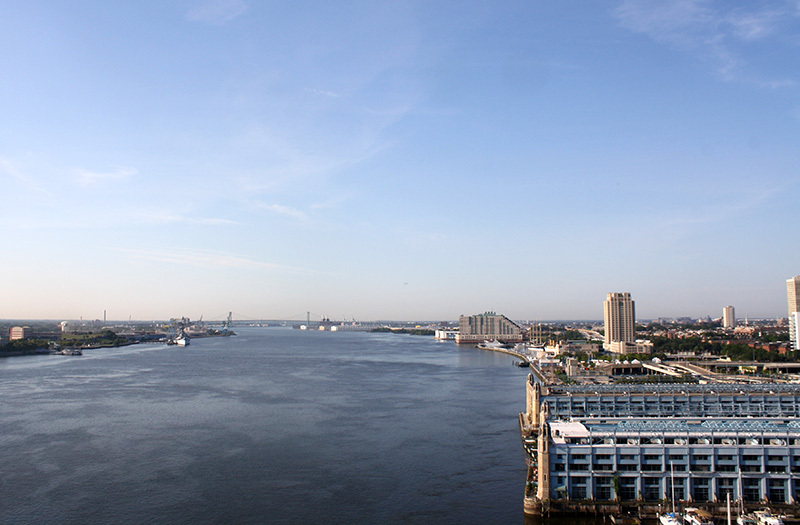Council to introduce waterfront setback ordinance at first meeting

On Thursday morning, when City Council reconvenes for its fall session, the Administration is expected to introduce an ordinance in cooperation with the Planning Commission which will bring to bear a 50-foot buffer to development on the City’s rivers and streams.
The buffer was included in the code passed by Council last December, but in June, Council passed an amendment to the code requiring that the Water Department’s hydrology map be approved by ordinance before the buffer takes effect. The Water Dept. worked to improve that map over the summer, and District Council members have met with various stakeholders to draft the ordinance to be introduced Thursday.
An advance copy of that ordinance, attached to this article, shows that among the changes from the code passed last year, the whole provision has been renamed, from “Stream Buffers” to “Waterfront Setbacks.” Whatever you want to call it, though, leaving a stretch of undeveloped land adjacent to waterways is considered a best practice among environmental groups.
For smaller streams, buffers with natural vegetation help prevent erosion, according to Chris Crockett, deputy commissioner of planning and environmental services for the Philadelphia Water Department.
“We want to maintain the integrity of any streams we have that are there now,” some of which are only “as wide as a desk,” Crockett said.
When grasses and shrubbery are simply allowed to grow next to such small waterways, their roots help strengthen the banks.
On some larger waterways like the Wissahickon—which, over the past three weeks since the enactment of the new zoning code, has been without a setback for the first time in decades—buffers help protect drinking water sources, by filtering out pollutants and absorbing runoff.
“For every natural buffer I remove that helps treat the water at its source … I have to engineer something to take that pollution out,” Crockett said. “I have to make up for nature in some way.”
On the City’s largest waterways—the Delaware and Schuylkill rivers—natural buffers help protect water quality and improve the habitat for aquatic life. Crockett said that shad and even sturgeon have been showing signs of returning to the Lower Delaware, and keeping new development from the river’s edge will only accelerate that trend.
Crockett also said the setback is a useful tool in the Water Department’s effort to deal with flooding and the projected rise of sea levels.
“We have to think not just about people and structures being in harm’s way today, but people and structures being in harm’s way in the future,” Crockett said.
Since 2010, the Pennsylvania Department of Environmental Protection has required a setback—of 150 feet—only on waterways considered “High Quality” or “Exceptional Value,” according to DEP Community Relations Coordinator Lynda Rebarchak. Chris Crockett explained that such classifications only apply to the state’s most pristine, untouched streams. Many waterways—and all waterways in Philadelphia—are considered “impaired,” in that they’ve already been affected by development or pollution.
The DEP recommends, but does not require, a 100-foot setback on all Pennsylvania waterways, regardless of condition.
“It really comes down to having a good local ordinance,” Crockett said.
For the working group formed by Councilman Green’s office late this summer, the Water Department produced a “benchmarking study” (attached) in order to provide some context for Philadelphia’s setback in light of what’s been enacted in other cities. The Department reviewed laws in Baltimore, Chicago, Cincinnati, Detroit, Louisville, Minneapolis, New York, Pittsburgh, Portland, St. Louis, Washington, and Wilmington. It found that only two of those river-port cities, Detroit and St. Louis, had no buffer requirement at all, while the rest have enacted buffers of 25 to 200 feet.
Various uses are permitted within the setbacks of some of those cities, and a number of uses are explicitly permitted and prohibited within the setback in the ordinance to be introduced Thursday. The ordinance prohibits “permanent or temporary structures, except for docks, piers, and structures accessory to public parks and open space, outdoor storage of materials, roads and driveways, parking lots, and any other directly connected impervious surface, except for recreational trails, which must conform to any design regulations adopted by the [Planning] Commission.”
“Clearing of native or non-invasive vegetation” has been removed from the list of prohibited uses, and “stormwater management functions” added to the list of permitted uses. A new section of special controls for the Delaware and Schuylkill rivers has also been added, clarifying that certain industrial and water-related uses are permitted in the setback, “provided they are permitted by the underlying zoning, and the Commission determines that they are compatible with existing adjacent uses, including any public parks and open space or recreational trails located in the waterfront setback …”
Of course, the setback doesn’t serve environmental goals only. Since recreational uses are to be allowed within fifty feet of the rivers, it leaves open the possibility of public use of the Delaware waterfront. That possibility is what caused concern for Development Workshop’s Craig Schelter, who suggested that the City was trying to take portions of private property through zoning, without paying for acquisition.
But members of the Planning Commission have pointed out that setbacks are a common zoning tool—perhaps this was the thinking behind changing the name from “buffer”—and do not constitute a taking of private property.
In its efforts to maximize public access to the river, the Delaware River Waterfront Corporation has negotiated various license agreements with owners of waterfront property. Some of these agreements are yearly renewed easements, revocable by either party with 90 days’ notice, which allow DRWC to build and maintain public trails on privately held land, such as at the site of the formerly proposed Foxwoods casino between Tasker and Reed streets on the Delaware waterfront. DRWC President Tom Corcoran said the agreement has proven to be a viable way for the City to utilize waterfront property without condemnation and acquisition.
“I think establishing the 50-foot setback throughout the city, and particularly on the Central Delaware, creates the framework for us to negotiate these types of agreements going forward,” Corcoran said.
Contact the reporter at jaredbrey@gmail.com and follow him on Twitter @jaredbrey
Correction 9/13/12: An earlier version of this article stated that Councilman Bill Green would introduce the ordinance. He will not.
WHYY is your source for fact-based, in-depth journalism and information. As a nonprofit organization, we rely on financial support from readers like you. Please give today.






